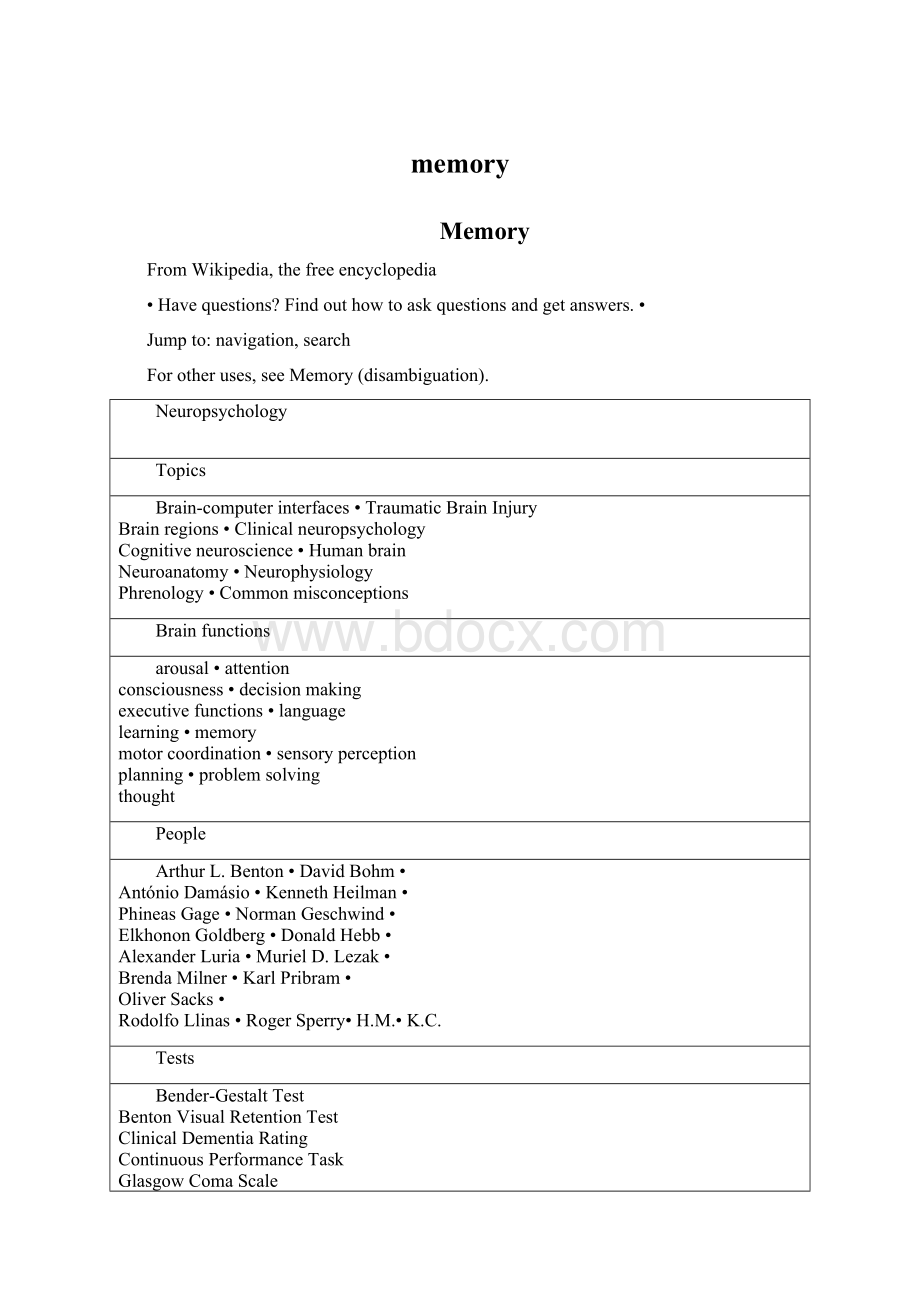memory文档格式.docx
《memory文档格式.docx》由会员分享,可在线阅读,更多相关《memory文档格式.docx(27页珍藏版)》请在冰豆网上搜索。

get
answers.
•
Jumpto:
navigation,search
Forotheruses,seeMemory(disambiguation).
Neuropsychology
Topics
Brain-computerinterfaces•TraumaticBrainInjury
Brainregions•Clinicalneuropsychology
Cognitiveneuroscience•Humanbrain
Neuroanatomy•Neurophysiology
Phrenology•Commonmisconceptions
Brainfunctions
arousal•attention
consciousness•decisionmaking
executivefunctions•language
learning•memory
motorcoordination•sensoryperception
planning•problemsolving
thought
People
ArthurL.Benton•DavidBohm•
Antó
nioDamá
sio•KennethHeilman•
PhineasGage•NormanGeschwind•
ElkhononGoldberg•DonaldHebb•
AlexanderLuria•MurielD.Lezak•
BrendaMilner•KarlPribram•
OliverSacks•
RodolfoLlinas•RogerSperry•H.M.•K.C.
Tests
Bender-GestaltTest
BentonVisualRetentionTest
ClinicalDementiaRating
ContinuousPerformanceTask
GlasgowComaScale
HaylingandBrixtontests
Lexicaldecisiontask
Mini-mentalstateexamination
Stroopeffect
WechslerAdultIntelligenceScale
Wisconsincardsortingtask
Tools
JohariWindow
MindandBrainPortal
Thisbox:
view
talk
edit
Inpsychology,memoryisanorganism'
sabilitytostore,retain,andsubsequentlyretrieveinformation.Traditionalstudiesofmemorybeganintherealmsofphilosophy,includingtechniquesofartificiallyenhancingthememory.
Thelatenineteenthandearlytwentiethcenturyputmemorywithintheparadigmsofcognitivepsychology.Inrecentdecades,ithasbecomeoneoftheprincipalpillarsofabranchofsciencecalledcognitiveneuroscience,aninterdisciplinarylinkbetweencognitivepsychologyandneuroscience.
Contents
[hide]
1Processes
2Classification
2.1Sensory
2.2Short-term
2.3Long-term
3Models
3.1Multi-store(Atkinson-Shiffrinmemorymodel)
3.2Workingmemory
3.3Levelsofprocessing
4Classificationbyinformationtype
5Classificationbytemporaldirection
6Physiology
7Disorders
8Memorization
9Improvingmemory
10MemoryTasks
11Culturalreferences
12Seealso
13Notes
14References
15Externallinks
[edit]Processes
Thereareseveralwaystoclassifymemories,basedonduration,natureandretrievalofinformation.Fromaninformationprocessingperspectivetherearethreemainstagesintheformationandretrievalofmemory:
Encodingorregistration(processingandcombiningofreceivedinformation)
Storage(creationofapermanentrecordoftheencodedinformation)
Retrievalorrecall(callingbackthestoredinformationinresponsetosomecueforuseinaprocessoractivity)
[edit]Classification
Abasicandgenerallyacceptedclassificationofmemoryisbasedonthedurationofmemoryretention,andidentifiesthreedistincttypesofmemory:
sensorymemory,shorttermmemoryandlongtermmemory.
[edit]Sensory
Sensorymemorycorrespondsapproximatelytotheinitial200-500millisecondsafteranitemisperceived.Theabilitytolookatanitem,andrememberwhatitlookedlikewithjustasecondofobservation,ormemorization,isanexampleofsensorymemory.Withveryshortpresentations,participantsoftenreportthattheyseemto"
see"
morethantheycanactuallyreport.ThefirstexperimentsexploringthisformofsensorymemorywereconductedbyGeorgeSperlingusingthe"
partialreportparadigm."
Subjectswerepresentedwithagridof12letters,arrangedintothreerowsof4.Afterabriefpresentation,subjectswerethenplayedeitherahigh,mediumorlowtone,cuingthemwhichoftherowstoreport.Basedonthesepartialreportexperiments,Sperlingwasabletoshowthatthecapacityofsensorymemorywasapproximately12items,butthatitdegradedveryquickly(withinafewhundredmilliseconds).Becausethisformofmemorydegradessoquickly,participantswouldseethedisplay,butbeunabletoreportalloftheitems(12inthe"
wholereport"
procedure)beforetheydecayed.Thistypeofmemorycannotbeprolongedviarehearsal.
[edit]Short-term
Someoftheinformationinsensorymemoryisthentransferredtoshort-termmemory.Short-termmemoryallowsonetorecallsomethingfromseveralsecondstoaslongasaminutewithoutrehearsal.Itscapacityisalsoverylimited:
GeorgeA.Miller,whenworkingatBellLaboratories,conductedexperimentsshowingthatthestoreofshorttermmemorywas7±
2items(thetitleofhisfamouspaper,"
Themagicalnumber7±
2"
).Modernestimatesofthecapacityofshort-termmemoryarelower,typicallyontheorderof4-5items,andweknowthatmemorycapacitycanbeincreasedthroughaprocesscalledchunking.Forexample,ifpresentedwiththestring:
FBIPHDTWAIBM
peopleareabletorememberonlyafewitems.However,ifthesameinformationispresentedinthefollowingway:
FBIPHDTWAIBM
peoplecanrememberagreatdealmoreletters.Thisisbecausetheyareabletochunktheinformationintomeaningfulgroupsofletters.Beyondfindingmeaningintheabbreviationsabove,HerbertSimonshowedthattheidealsizeforchunkinglettersandnumbers,meaningfulornot,wasthree.Thismaybereflectedinsomecountriesinthetendencytorememberphonenumbersasseveralchunksofthreenumberswiththefinalfour-numbergroupsgenerallybrokendownintotwogroupsoftwo.
Short-termmemoryisbelievedtorelymostlyonanacousticcodeforstoringinformation,andtoalesserextentavisualcode.Conrad(1964)[1]foundthattestsubjectshadmoredifficultyrecallingcollectionsofwordsthatwereacousticallysimilar(e.g.dog,hog,fog,bog,log).
[edit]Long-term
Thestorageinsensorymemoryandshort-termmemorygenerallyhaveastrictlylimitedcapacityandduration,whichmeansthatinformationisavailableforacertainperiodoftime,butisnotretainedindefinitely.Bycontrast,long-termmemorycanstoremuchlargerquantitiesofinformationforpotentiallyunlimitedduration(sometimesawholelifespan).Forexample,givenarandomseven-digitnumber,wemayrememberitforonlyafewsecondsbeforeforgetting,suggestingitwasstoredinourshort-termmemory.Ontheotherhand,wecanremembertelephonenumbersformanyyearsthroughrepetition;
thisinformationissaidtobestoredinlong-termmemory.Whileshort-termmemoryencodesinformationacoustically,long-termmemoryencodesitsemantically:
Baddeley(1966)[2]discoveredthatafter20minutes,testsubjectshadtheleastdifficultyrecallingacollectionofwordsthathadsimilarmeanings(e.g.big,large,great,huge).
Short-termmemoryissupportedbytransientpatternsofneuronalcommunication,dependentonregionsofthefrontallobe(especiallydorsolateralprefrontalcortex)andtheparietallobe.Long-termmemories,ontheotherhand,aremaintainedbymorestableandpermanentchangesinneuralconnectionswidelyspreadthroughoutthebrain.Thehippocampusisessentialtotheconsolidationofinformationfromshort-termtolong-termmemory,althoughitdoesnotseemtostoreinformationitself.Rather,itmaybeinvolvedinchangingneuralconnectionsforaperiodofthreemonthsormoreaftertheinitiallearning.
Oneoftheprimaryfunctionsofsleepisimprovingconsolidationofinformation,asitcanbeshownthatmemorydependsongettingsufficientsleepbetweentrainingandtest,andthatthehippocampusreplaysactivityfromthecurrentdaywhilesleeping.
[edit]Models
Modelsofmemoryprovideabstractrepresentationsofhowmemoryisbelievedtowork.Belowareseveralmodelsproposedovertheyearsbyvariouspsychologists.Notethatthereissomecontroversyastowhetherthereareseveralmemorystructures,forexample,Tarnow(2005)findsthatitislikelythatthereisonlyonememorystructurebetween6and600seconds.
[edit]Multi-store(Atkinson-Shiffrinmemorymodel)
Themulti-storemodel(alsoknownasAtkinson-Shiffrinmemorymodel)wasfirstrecognisedin1968byAtkinsonandShiffrin.
Themulti-storemodelhasbeencriticizedforbeingtoosimplistic.Forinstance,long-termmemoryisbelievedtobeactuallymadeupofmultiplesubcomponents,suchasepisodicandproceduralmemory.Italsoproposesthatrehearsalistheonlymechanismbywhichinformationeventuallyreacheslong-termstorage,butevidenceshowsuscapableofrememberingthingswithoutrehearsal.
(Seealso:
Memoryconsolidation)
[edit]Workingmemory
Theworkingmemorymodel.
In1974BaddeleyandHitchproposedaworkingmemorymodelwhichreplacedtheconceptofgeneralshorttermmemorywithspecific,activecomponents.Inthismodel,workingmemoryconsistsofthreebasicstores:
thecentralexecutive,thephonologicalloopandthevisuo-spatialsketchpad.In2000thismodelwasexpandedwiththemultimodalepisodicbuffer.[3]
Thecentralexecutiveessentiallyactsasattention.Itchannelsinformationtothethreecomponentprocesses:
thephonologicalloop,thevisuo-spatialsketchpad,andtheepisodicbuffer.
Thephonologicalloopstoresauditoryinformationbysilentlyrehearsingsoundsorwordsinacontinuousloop;
thearticulatoryprocess(the"
innervoice"
)continuously"
speaks"
thewordstothephonologicalstore(the"
innerear"
).Thephonologicalloophasaverylimitedcapacity,whichisdemonstratedbythefactthatitiseasiertorememberalistofshortwords(e.g.dog,wish,love)thanalistoflongwords(e.g.association,systematic,confabulate)becauseshortwordsfitbetterintheloop.However,ifthetestsubjectisgivenataskthattiesupthearticulatoryprocess(saying"
the,the,the"
overandoveragain),thenalistofshortwordsisnoeasiertoremember.
Thevisuo-spatialsketchpadstoresvisualandspatialinforma